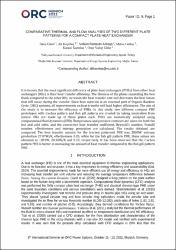COMPARATIVE THERMAL AND FLOW ANALYSES OF TWO DIFFERENT PLATE PATTERNS FOR A COMPACT PLATE HEAT EXCHANGER

Göster/
Tarih
2022Yazar
Gürel, BarışKeçebaş, Ali
Akkaya, Volkan Ramazan
Göltaş, Merve
Kurtuluş, Karani
Güler, Onur Vahip
Üst veri
Tüm öğe kaydını gösterKünye
Gürel, B., A. Keçebaş, V. R. Akkaya, M. Göltaş, K. Kurtuluş, and O. V. Güler. 2021. "COMPARATIVE THERMAL AND FLOW ANALYSES OF TWO DIFFERENT PLATE PATTERNS FOR A COMPACT PLATE HEAT EXCHANGERÖzet
It is known that the most significant difference of plate heat exchangers (PHEs) from other heat exchangers (HEs) is their heat transfer efficiency. The thinness of the plates separating the two fluids compared to the other HEs increases the heat transfer rate and decreases the heat losses that will occur during the transfer. Since heat rejection is an essential part of Organic Rankine Cycle (ORC) systems, all improvements on heat transfer will lead higher efficiencies. The aim of the study is to increase the efficiency of PHEs. In this study, two different compact PHE prototypes with trachea pattern and fish gill pattern are created by taking inspiration from nature. HEs are made up of three plates each. PHEs are numerically analyzed using computational fluid dynamics (CFD). Temperature and pressure contours are taken for both the hot and cold sides, and the convective heat transfer coefficient, Reynold's number, Prandtl number, effectiveness and entropy generation are calculated. The results obtained are compared. The heat transfer amount for the trachea patterned PHE was 2800W, entropy production 27.07W/K, effectiveness 0.26, while for the fish gill pattern PHE, these values are obtained as 1881W, 20.26W/K and 0.18, respectively. It has been observed that the trachea pattern PHE is better in increasing the amount of heat transfer compared to the fish gill pattern PHE.

















